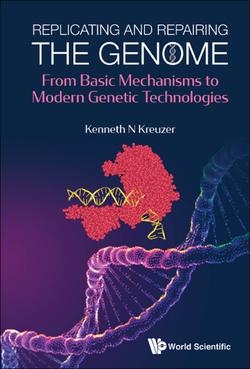Читать книгу Replicating And Repairing The Genome: From Basic Mechanisms To Modern Genetic Technologies - Kenneth N Kreuzer - Страница 43
4.3MCM complex — the replicative helicase in eukaryotes
ОглавлениеAs mentioned above, the eukaryotic replicative helicase is a hexameric enzyme with a hole in the middle large enough to accommodate DNA. The enzyme is called the MCM complex, a name that was derived from the phenotype of mutants that first defined the genes encoding the subunits (Mini-chromosome maintenance; involved in maintaining small artificial chromosomes in yeast). Like the bacterial and bacteriophage T7 enzymes, the MCM complex tracks along ssDNA by essentially walking along the DNA that passes through the middle; it is not yet known whether the eukaryotic helicase tracks along DNA by the hand-over-hand mechanism used by the T7 helicase (Section 2.4). The eukaryotic MCM complex is not evolutionarily related to the bacterial or T7 enzymes, and key characteristics of the enzymes differ.
The most dramatic difference, which was a big surprise when discovered, is that the MCM complex has the opposite polarity when tracking along ssDNA compared to the bacterial and T7 enzymes. MCM is a 3′ to 5′ helicase, which means that it tracks along the leading strand of a replication fork rather than the lagging strand. In this fundamental way, the architecture of bacterial and eukaryotic replication differs from each other.
Unlike the homo-hexameric bacterial replicative helicase, the MCM complex is made up of six distinct but related subunits, each the product of a different gene (Figure 4.3). Each of these six subunits is a member of the AAA+ family of ATPase introduced in Chapter 3 in our discussion of clamp loaders. These subunits arrange themselves in a particular order around the ring, and the six different ATPases around the ring play specialized roles in loading, activation and unwinding. There is one particular subunit–subunit interface in the hexamer that cracks open to allow DNA strands to enter or leave, processes that we will discuss in the next Chapter on initiation and termination of replication.
The six-subunit MCM complex by itself is essentially inert for DNA unwinding. Indeed, for several years after its isolation, there was significant question as to whether MCM was indeed the replicative helicase due to this lack of activity. Direct evidence that MCM is the replicative helicase mounted when it was discovered that the homologous archaeal MCM complex had strong unwinding activity, and also when it was discovered that an aberrant form of eukaryotic MCM complex composed with only three of the six distinct subunits also had helicase activity. Finally, the key discovery was that the helicase activity of the native MCM hexamer was unmasked upon addition of several other proteins. The fully active complex, called the CMG complex, contains a protein called C
